Blumbomeniformes
Blumbomen and their relatives belong in a clade characterized by the grotesque fusion of the first two heads into a vaguely humanoid "face," possession of a facial pouch connected to the genital first head, (to store opulent genitals in males, to shelter the young in females.) and a preference for marine littoral environments.
Most Blumbomen live like penguins or small seals on Earth; cumbersome on land but graceful underwater. Their mouths conceal muscular, hose-like second heads, which are used to snap up swimming prey, or to grasp around for other organisms in sea plants, sediment or "coral" reefs. With the exception of some species that seasonally eat marine plants, they are all predators on small prey.
The relationships of the Blumbomeniformes have been hotly debated, but it seems most likely that they form a sister clade to the Pescidont Bumbos and relatives. Like Bumbos, Blumbomen also have extremely elongated second heads, reduced tails and a stocky body form. The two groups also resemble each other in foot morphology and certain details of the skeleton.
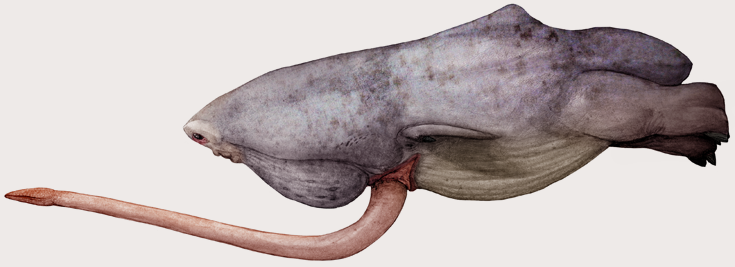
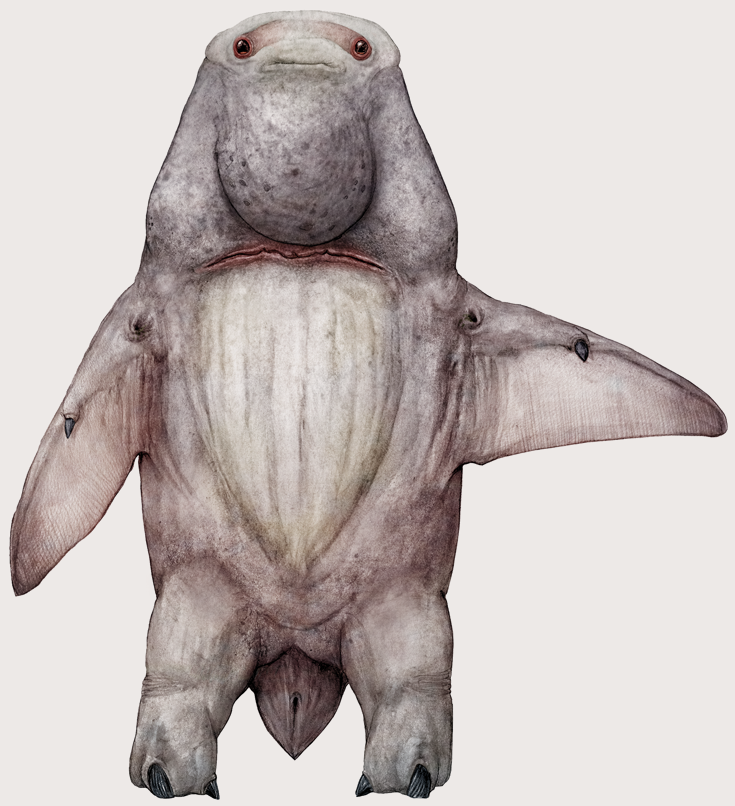
Species: Moronops gularis
Common Names: Blumbomen, Grey Blumbomen.
Size: Up to 1.2 meters tall.
Habitat: Isternian shores along the Sea of Oroland, numerous offshore islands, also present on Midland.
Moronops is perhaps the best-known “typical” Blumbomen on Snaiad. These noisy beasts form massed communities on beaches within their range, feeding on numerous marine organisms they catch by swimming or “kelp-browsing;” probing underwater growth with their hose-like secondary heads. Their stubby legs make them some of the least suitable of all true Blumbomen for a terrestrial lifestyle, but they still retain archaic characteristics like the claws on their fins.
Moronops is the archetypical organism that comes to mind when one thinks of Blumbomen on Snaiad. They are thoroughly incorporated in the planet’s popular culture, and have formed the basis for cartoon characters, children’s toys and even a music band.
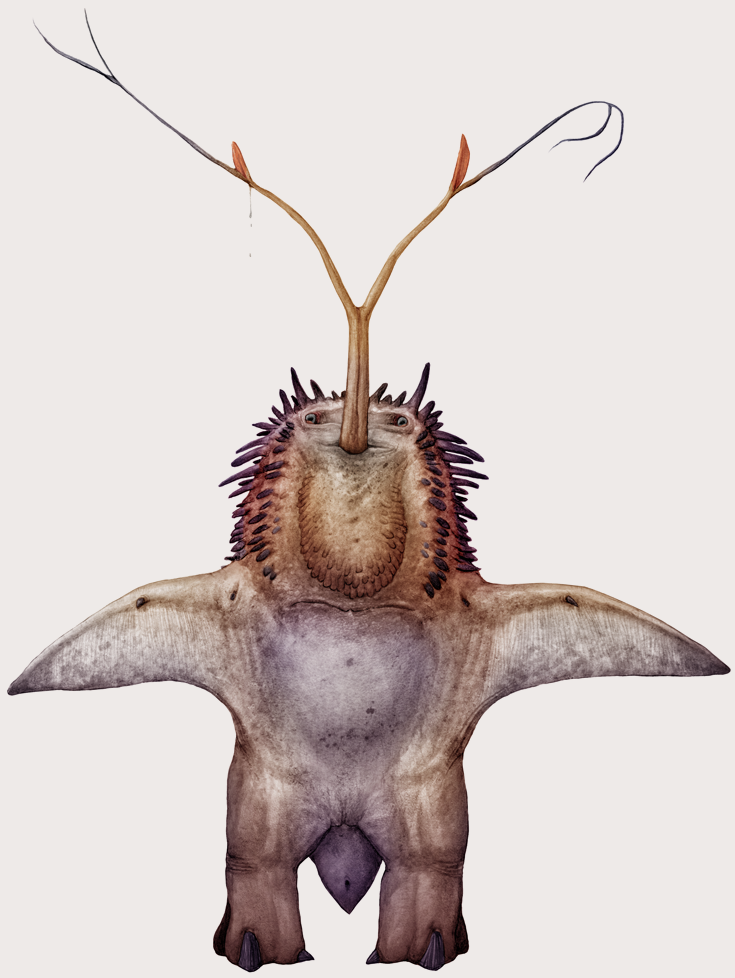
Species: Ugrops fascinatus
Common Name: Fascinating Blumbomen.
Size: 1 meter tall.
Habitat: Present on south-eastern shores of Aucaterra, Isla Skylla, also on Vesternian shores until the Tridaktylos.
The so-called “spectacular Blumbomen”, the genus Ugrops contains numerous closely related species living along the shores of Vesterna. These creatures are readily identifiable through the extravagant fleshy growths on their “faces”. The purpose of these structures, as unnoticeable as large warts in some species or long like streaming, fleshy tentacles in others, is not clearly understood. They are thought to serve as sexual displays, but both sexes have them in equal lengths. They may serve to break up their silhouette underwater, but it is questionable whether the huge underwater drag caused by their presence justifies their efficiency as anti-predator devices. Despite their outlandish looks, Ugrops and relatives are closely related to “typical” Blumbomen such as Moronops; the skeletons of some species look virtually identical. However, Ugrops do have longer and stronger back legs and spend more time on land. Eyewitness accounts even exist of them hunting small animals inland, although this is doubtlessly not a regular behavior.
The specimen illustrated here is brandishing the large and elaborate set of male genitals common in almost all Blumbomeniformes. In many species, the males use these impressive gonads in dazzling mating displays.
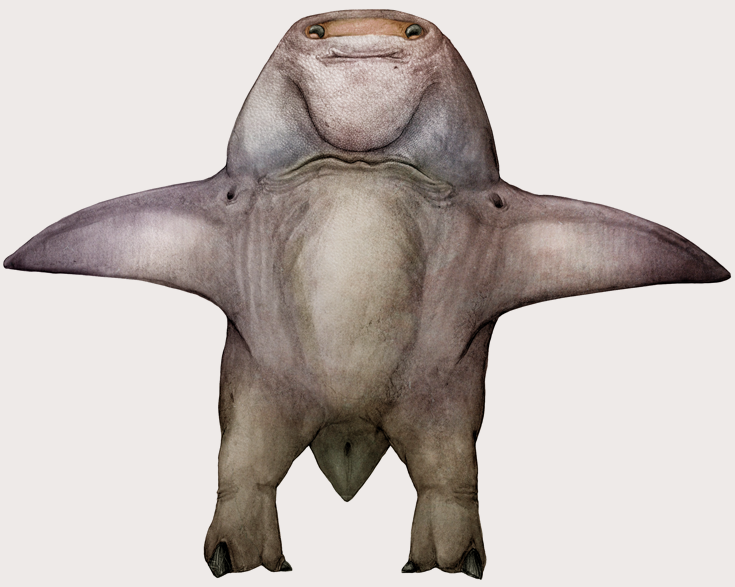
Species: Mikri anyx
Common Names: Smolblumbomen, Tiny Blumbomen, Water Baby.
Size: No larger than 70 centimeters tall.
Habitat: North-eastern Neomediterranean shores, limited to the area around Izmir.
This species belongs to a special group of Anychiforme Blumbomen that are more adapted to a marine existence than the most. They have lost terrestrial adaptations such as strong back legs and fin-claws, and have larger fins and a thickened layer of subcutaneous body fat that insulates them well underwater. They spend a large part of their lives in the sea, returning to land not even to give birth, but to mate. Every summer, crowds of these tiny Blumbomen get ashore around Izmir to mate, filling the beaches around the city with lively genital displays and noisy mating contests. After conception, the young are reared in the females’ genital pouches and are born in the sea. It is thought that these creatures’ land-lubbing orgies are evolutionary remnants of their more terrestrial ancestry.
Like most Anychiforme Blumbomen, Mikri is limited to shallow waters that stay warm the year round and has a very limited distribution. The city of Izmir just happens to be close to their mating sites, putting pressure on their populations. Currently, Mikri is protected as one of the city’s symbolic animals and Izmirnite beaches are closed to visitors during their mating season.
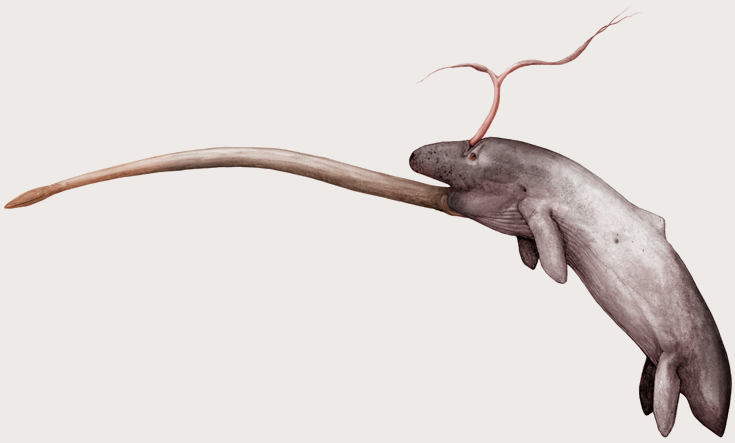
Species: Thalassomirifex larrana
Common Name: None
Size: Up to 10 meters long.
Habitat: Aaritic Ocean and surrounding seas, sightings common around the Sea of Aucaterra.
There are at least two radiations within the Blumbomen lineage that have specialized for a totally aquatic lifestyle. Thalassomirifex and its relatives form the larger of these two groups, known as the Hadroblumbomeniformes. These creatures have enormously-extended second heads, so long that they cannot be retracted into their bodies anymore. This condition, combined with their fat, cigarette-shaped bodies, makes them a look like crossovers between the Mesoplodont whales and the extinct Elasmosaurs of Earth. Thalassomirifex is an opportunistic open-sea hunter that feeds on pelagic swimming organisms and also makes phenomenal dives in pursuit of unknown prey.
The life details of this creature, other than its gigantic size, are little-known and it might be split into more species, or lumped together with other genera in the Hadroblumbomeniformes as studies go on. Almost certainly, more species in this enigmatic lineage await discovery in the oceans of Snaiad.

Species: Eumegapteros pelagicus
Common Names: Torpedocaster, Wingfish.
Size: Up to 3 meters long.
Habitat: Southern parts of the Middle Ocean, extending into the Sea of Beasts.
This species belongs in another purely-aquatic lineage within the Blumbomeniformes, distinct from the Hadroblumbomeniforme swimmers discussed earlier. It is thought that the presence of a sheltering face-pouch has made marine lifestyles easier within the group by enabling them carry their young underwater. Whatever the reasons for their evolution, Apodoblumbomeniformes such as Eumegapteros are characterized by the distinct lack of rear legs, the extensive development of the forelimbs into powerful fins and the dependence on well-developed eyes for locating prey. On the whole these creatures resemble terrestrial Blumbomen with no feet and a huge head with binocular-like, forward facing eyes. They either forage among underwater growth, or actively swim after their prey and capture them with rapid lunges of their second heads.
For mating, they have an even stranger adaptation, brought about by the pressures of sexual selection. Male Eumegapteros viciously chase down their female partners in the mating season. When close by, they launch their genitals, harpoon-like, from their primary heads. Their sexual organs, extravagant like in all Blumbomeniformes, have a very long (up to twice their body length,) stalk, tipped by a frontal mass bearing the sperm-producing glands and two tiny finlets. These fins steer the organ towards the females’ genitalia in a series of extremely rapid reflexes, effectively guiding them home like smart missiles. This behavior, only observed recently with high-speed underwater photography, has earned the nickname “Torpedocaster” for these creatures.
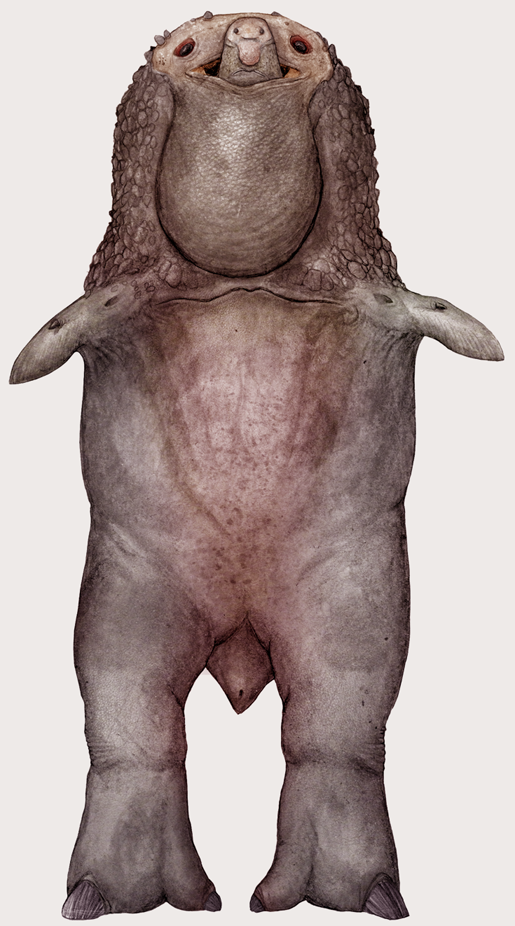
Species: Moai mapagalithops
Common Names: Giant Armless Blumbomen, Moai Landblumbomen.
Size: More than 2 meters tall.
Habitat: Shores and interior plains in the island of Mapag.
The wildly divergent adaptive radiation of established body plans in isolated environments is a long-observed fact. This phenomenon has visited the Blumbomeniformes at least once with the fascinating Giant Armless Blumbomen of the remote island of Mapag. While most members of their group are primarily marine, the furthest these Blumbomen venture into water is to certain swamps and secluded beaches to drink and sleep. They are completely terrestrial and feed on a mixture of terrestrial fruits, sprog, small animals and beached carrion. Their great size, combined with their horny head-scutes and the ability to vomit stomach acid under stress, protects them from Mapagian predators such as Brute Turtles. (Phobochelys molestor) While neither the Moai are efficient browsers, or the Brute Turtles efficient predators, the absence of any other large animal in the isolated ecosystem of Mapag ensures their continued survival.
The genus name of these creatures refers to the gigantic Moai statues of Earth, and was the subject of intensive debate on whether it was right to propagate the myth of Earth on Snaiad, where no immediate return back to home is possible. A captive colony of these adorable creatures has been established on the island of Hania on the Neomediterranean. This picture shows a female Moai, with a juvenile sitting safely in its bulbous, nose like genital sac.
Copyright laws protect all intellectual property associated with Snaiad.
All artwork, concepts and names associated with this project belong to C. M. Kosemen, unless otherwise stated.
